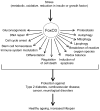FOXO3: A Major Gene for Human Longevity--A Mini-Review
- PMID: 25832544
- PMCID: PMC5403515
- DOI: 10.1159/000375235
FOXO3: A Major Gene for Human Longevity--A Mini-Review
Abstract
Background: The gene FOXO3, encoding the transcription factor forkhead box O-3 (FoxO3), is one of only two for which genetic polymorphisms have exhibited consistent associations with longevity in diverse human populations.
Objective: Here, we review the multitude of actions of FoxO3 that are relevant to health, and thus healthy ageing and longevity.
Methods: The study involved a literature search for articles retrieved from PubMed using FoxO3 as keyword.
Results: We review the molecular genetics of FOXO3 in longevity, then current knowledge of FoxO3 function relevant to ageing and lifespan. We describe how FoxOs are involved in energy metabolism, oxidative stress, proteostasis, apoptosis, cell cycle regulation, metabolic processes, immunity, inflammation and stem cell maintenance. The single FoxO in Hydra confers immortality to this fresh water polyp, but as more complex organisms evolved, this role has been usurped by the need for FoxO to control a broader range of specialized pathways across a wide spectrum of tissues assisted by the advent of as many as 4 FoxO subtypes in mammals. The major themes of FoxO3 are similar, but not identical, to other FoxOs and include regulation of cellular homeostasis, particularly of stem cells, and of inflammation, which is a common theme of age-related diseases. Other functions concern metabolism, cell cycle arrest, apoptosis, destruction of potentially damaging reactive oxygen species and proteostasis.
Conclusions: The mechanism by which longevity-associated alleles of FOXO3 reduce age-related mortality is currently of great clinical interest. The prospect of optimizing FoxO3 activity in humans to increase lifespan and reduce age-related diseases represents an exciting avenue of clinical investigation. Research strategies directed at developing therapeutic agents that target FoxO3, its gene and proteins in the pathway(s) FoxO3 regulates should be encouraged and supported.
© 2015 S. Karger AG, Basel.
Conflict of interest statement
The authors have no financial conflicts of interest.
Figures


References
-
- Furuyama T, Yamashita H, Kitayama K, Higami Y, Shimokawa I, Mori N. Effects of aging and caloric restriction on the gene expression of Foxo1, 3, and 4 (FKHR, FKHRL1, and AFX) in the rat skeletal muscles. Microsc Res Tech. 2002;59:331–334. - PubMed
-
- Morris BJ. Seven sirtuins for seven deadly diseases of aging. Free Radic Biol Med. 2013;56:133–71. - PubMed
-
- Eijkelenboom A, Burgering BM. FOXOs: signalling integrators for homeostasis maintenance. Nat Rev Mol Cell Biol. 2013;14:83–97. - PubMed
Publication types
MeSH terms
Substances
Grants and funding
LinkOut - more resources
Full Text Sources
Other Literature Sources
Research Materials

